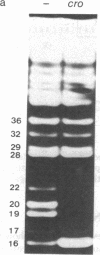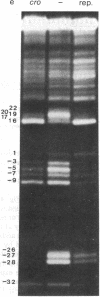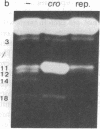Abstract
The mechanism of action of cro protein was probed by measuring its ability to protect DNA against methylation by dimethyl sulfate and its effect on transcription in vitro. The cro protein binds to the same three sites in the right operator (OR) of bacteriophage lambda DNA as does the lambda repressor. Dimethyl sulfate protection experiments reveal major groove contacts for both proteins, and cro protein protects from methylation a subset of those purines protected by lambda repressor. These experiments also show that the relative affinity of these two proteins for the three operator sites is different: whereas lambda repressor binds with an affinity OR1 greater than OR2 greater than OR3, the order for cro protein is OR3 greater than (OR1, OR2). As predicted by these results, cro protein, like the lambda repressor, blocks in vitro transcription of cI and cro from the two divergent promoters that overlap OR. Also as predicted, transcription of cI is turned off at lower cro protein concentrations than is transcription of cro, whereas the opposite order of repression is obtained with lambda repressor. These results describe the molecular mechanism of cro protein action and show that two regulatory proteins can bind to the same three adjacent sites in DNA with markedly different consequences.
Full text
PDF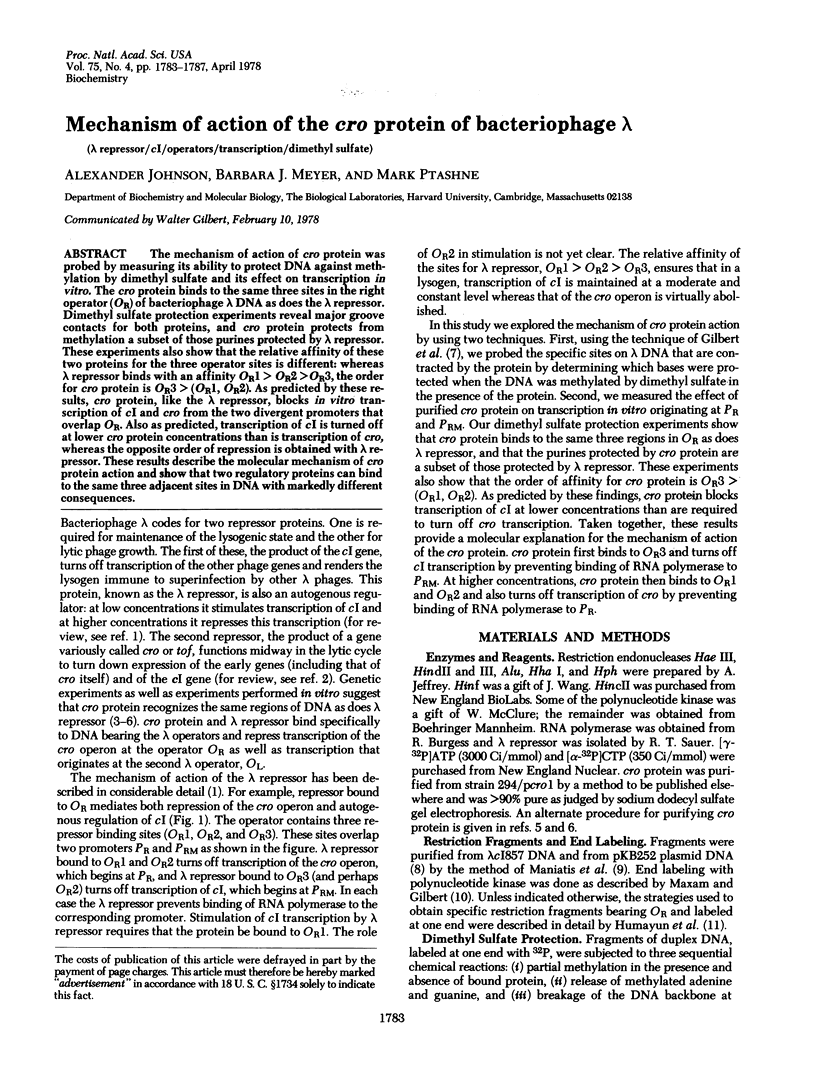
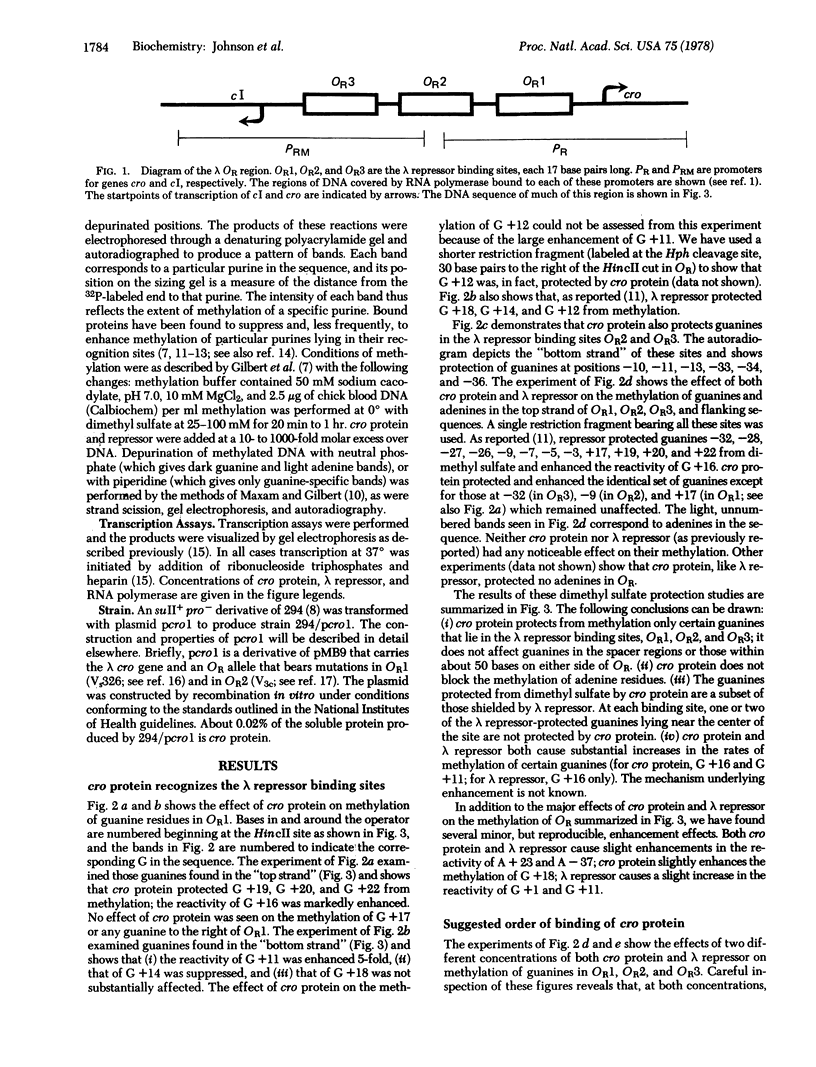
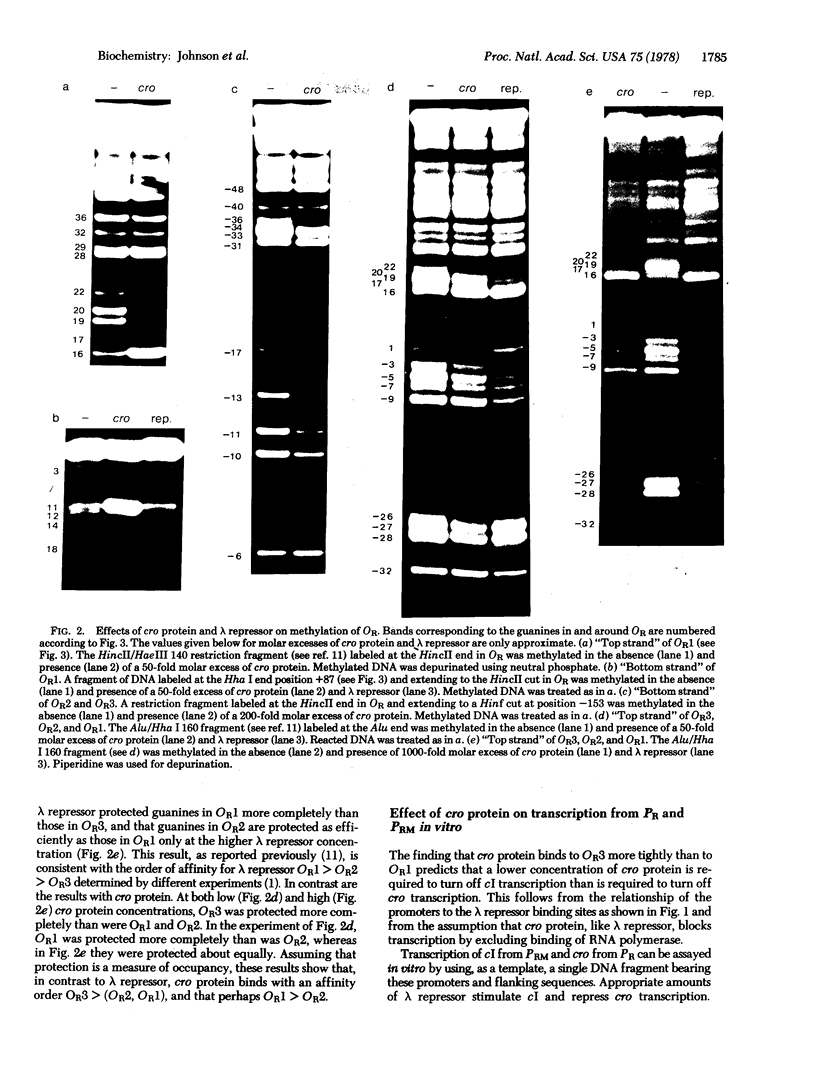
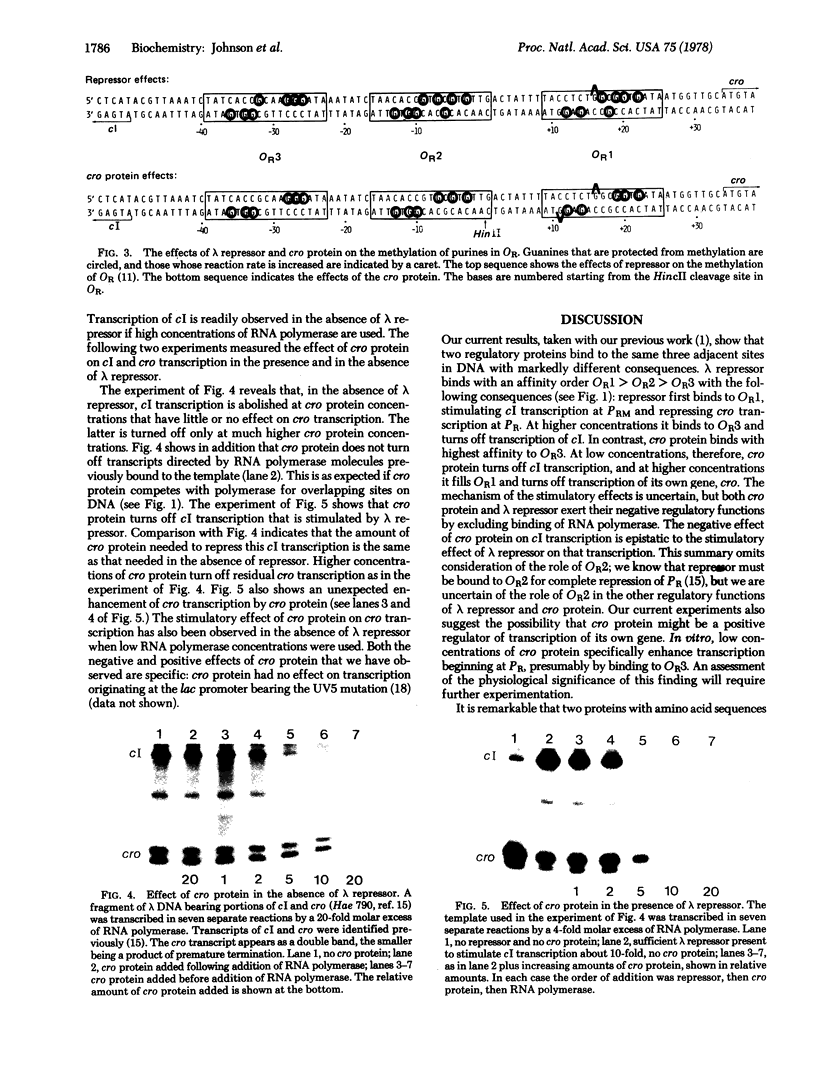
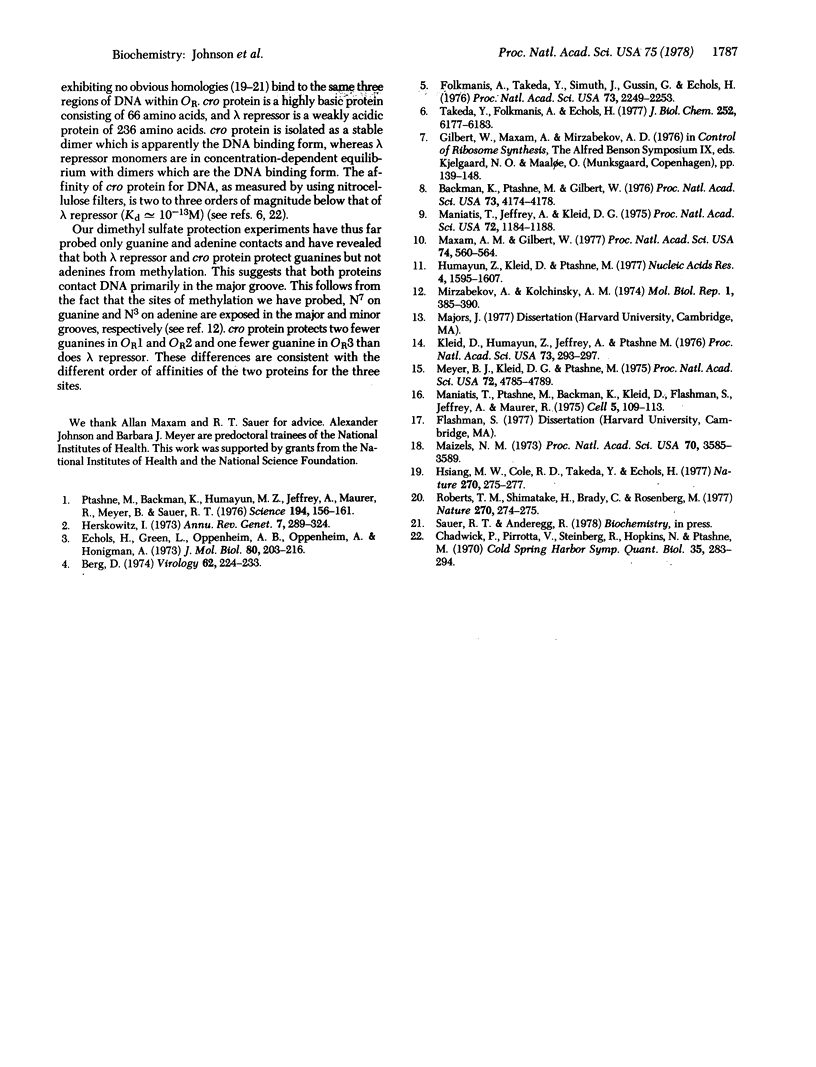
Images in this article
Selected References
These references are in PubMed. This may not be the complete list of references from this article.
- Backman K., Ptashne M., Gilbert W. Construction of plasmids carrying the cI gene of bacteriophage lambda. Proc Natl Acad Sci U S A. 1976 Nov;73(11):4174–4178. doi: 10.1073/pnas.73.11.4174. [DOI] [PMC free article] [PubMed] [Google Scholar]
- Berg D. E. Genes of phage lambda essential for lambda dv plasmids. Virology. 1974 Nov;62(1):224–233. doi: 10.1016/0042-6822(74)90317-1. [DOI] [PubMed] [Google Scholar]
- Echols H., Green L., Oppenheim A. B., Oppenheim A., Honigman A. Role of the cro gene in bacteriophage lambda development. J Mol Biol. 1973 Oct 25;80(2):203–216. doi: 10.1016/0022-2836(73)90167-8. [DOI] [PubMed] [Google Scholar]
- Folkmanis A., Takeda Y., Simuth J., Gussin G., Echols H. Purification and properties of a DNA-binding protein with characteristics expected for the Cro protein of bacteriophage lambda, a repressor essential for lytic growth. Proc Natl Acad Sci U S A. 1976 Jul;73(7):2249–2253. doi: 10.1073/pnas.73.7.2249. [DOI] [PMC free article] [PubMed] [Google Scholar]
- Herskowitz I. Control of gene expression in bacteriophage lambda. Annu Rev Genet. 1973;7:289–324. doi: 10.1146/annurev.ge.07.120173.001445. [DOI] [PubMed] [Google Scholar]
- Hsiang M. W., Cole R. D., Takeda Y., Echols H. Amino acid sequence of Cro regulatory protein of bacteriophage lambda. Nature. 1977 Nov 17;270(5634):275–277. doi: 10.1038/270275a0. [DOI] [PubMed] [Google Scholar]
- Humayun Z., Kleid D., Ptashne M. Sites of contact between lambda operators and lambda repressor. Nucleic Acids Res. 1977;4(5):1595–1607. doi: 10.1093/nar/4.5.1595. [DOI] [PMC free article] [PubMed] [Google Scholar]
- Kleid D., Humayun Z., Jeffrey A., Ptashne M. Novel properties of a restriction endonuclease isolated from Haemophilus parahaemolyticus. Proc Natl Acad Sci U S A. 1976 Feb;73(2):293–297. doi: 10.1073/pnas.73.2.293. [DOI] [PMC free article] [PubMed] [Google Scholar]
- Maizels N. M. The nucleotide sequence of the lactose messenger ribonucleic acid transcribed from the UV5 promoter mutant of Escherichia coli. Proc Natl Acad Sci U S A. 1973 Dec;70(12):3585–3589. doi: 10.1073/pnas.70.12.3585. [DOI] [PMC free article] [PubMed] [Google Scholar]
- Maniatis T., Jeffrey A., Kleid D. G. Nucleotide sequence of the rightward operator of phage lambda. Proc Natl Acad Sci U S A. 1975 Mar;72(3):1184–1188. doi: 10.1073/pnas.72.3.1184. [DOI] [PMC free article] [PubMed] [Google Scholar]
- Maniatis T., Ptashne M., Backman K., Kield D., Flashman S., Jeffrey A., Maurer R. Recognition sequences of repressor and polymerase in the operators of bacteriophage lambda. Cell. 1975 Jun;5(2):109–113. doi: 10.1016/0092-8674(75)90018-5. [DOI] [PubMed] [Google Scholar]
- Maxam A. M., Gilbert W. A new method for sequencing DNA. Proc Natl Acad Sci U S A. 1977 Feb;74(2):560–564. doi: 10.1073/pnas.74.2.560. [DOI] [PMC free article] [PubMed] [Google Scholar]
- Meyer B. J., Kleid D. G., Ptashne M. Lambda repressor turns off transcription of its own gene. Proc Natl Acad Sci U S A. 1975 Dec;72(12):4785–4789. doi: 10.1073/pnas.72.12.4785. [DOI] [PMC free article] [PubMed] [Google Scholar]
- Mirzabekov A. D., Kolchinsky A. M. Localization of some molecules within the grooves of DNA by modification of their complexes with dimethyl sulphate. Mol Biol Rep. 1974 Sep;1(7):385–390. doi: 10.1007/BF00385670. [DOI] [PubMed] [Google Scholar]
- Ptashne M., Backman K., Humayun M. Z., Jeffrey A., Maurer R., Meyer B., Sauer R. T. Autoregulation and function of a repressor in bacteriophage lambda. Science. 1976 Oct 8;194(4261):156–161. doi: 10.1126/science.959843. [DOI] [PubMed] [Google Scholar]
- Roberts T. M., Shimatake H., Brady C., Rosenberg M. Sequence of Cro gene of bacteriophage lambda. Nature. 1977 Nov 17;270(5634):274–275. doi: 10.1038/270274a0. [DOI] [PubMed] [Google Scholar]
- Takeda Y., Folkmanis A., Echols H. Cro regulatory protein specified by bacteriophage lambda. Structure, DNA-binding, and repression of RNA synthesis. J Biol Chem. 1977 Sep 10;252(17):6177–6183. [PubMed] [Google Scholar]




